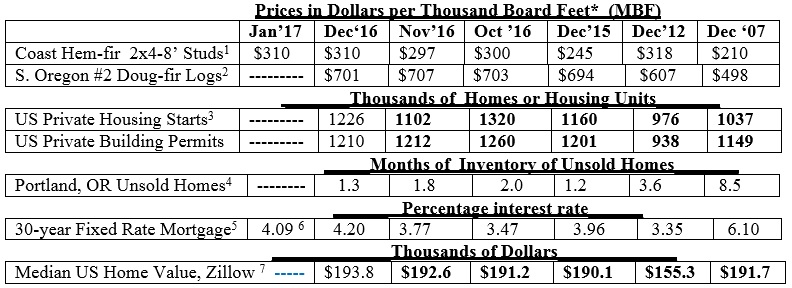By Rick Sohn, PhD
Umqua Coquille LLC
Timber Industry Report
January 28, 2017
Interest rates are leveling off, lumber and logs are steady, home values continue a steady rise, and housing starts are rising slowly, despite tightening home inventories. Canadian lumber exports are creating headaches. Recent trends of lumber, logs, home construction, and housing markets, are compared.
* A lumber board foot measures 12 inches by 12 inches by 1 inch. The log board foot is based on an industry standard pattern for sawing straight boards from round, tapered logs. The leftover wood and bark become chips and sawdust, which are used for paper, fiberboard, and fuel to make electric power. In the Pacific Northwest two truckloads of logs make enough wood product to build a new home.
Interpretation and Looking Ahead.
The Great Recession of 2008 seems like just yesterday, but it was 9 years ago!! This year, we will track the statistics of 2012 and 2007, 5 and 10 years ago respectively, for comparisons. In 2007 the country was falling into the recession, and by 2012 the country was climbing out of the recession – except for home values, housing starts, and real estate, that didn’t hit their lows until early 2012.
Recent monthly mortgage interest rates are up and down. November 10, the mortgage interest rate was 3.57%. By Dec 29, 7 weeks later, it peaked at 4.32. It backed off to 4.09, as of January 19.
Random lengths reports that the shipment of Canadian lumber to the United States increased from 3 billion board feet to 4 billion board feet, in 2016 alone, an increase of 33%. This has happened after the October, 2015, expiration of the lumber trade and tariffs agreement between the US and Canada. On Nov 25, 2016, a coalition of US softwood lumber producers petitioned the US Government (Department of Commerce and International Trade Commission) to restore the schedule of tariffs on Canadian imports that had been in place for the prior 10 years. Stay tuned.
If this increased amount of Canadian lumber were not flooding the United States, either prices would be higher, or Pacific Northwest production would rise, since there is unused manufacturing capacity. As housing starts continue their gradual rise, this benefits the timber-based economy either way.
Meanwhile, unsold home inventory is at a very low level in Portland, which is not uncommon for December. The Zillow national median home prices continue their steady climb. Housing starts have still not recovered to the numbers reached in October of 2016, but hopefully the early spring months will cure the drop.
Log Prices actually held quite steady for October, November and December. Whether the more typical winter price rise of logs is ahead of us or not, is impossible to tell at this time. Regarding lumber, we can only hope for spring prices like 2013, when the price went from $318 in December, 2012 to $430 then $445 in March and April of 2013, before dropping back to the 310-320 level by the end of 2013. This is where the price is now.
Next month will begin to tell us what builders are planning for the spring, and hopefully the wild weather of the last couple of months will become more normal.
— Figures in bold adjust monthly. Data used with permission. 1Random Lengths. Recent week Kiln Dried 2×4-8′ PET #2/#2&Btr Hem-fir stud lumber. 2RISI, Log Lines. Douglas-fir #2 Sawmill Log Average, Southern Oregon region. 3 Annualized monthly. US Dept of Commerce. 4Portland, Oregon Regional Multiple Listing Service, courtesy of Janet Johnston, Prudential Real Estate Professionals, Roseburg, OR. 5Freddie Mac. National monthly average. 6 Federal Reserve Bank of St Louis Economic Research, National Average, most recent week. 7Zillow.com, National Median home value. (http://www.zillow.com/or/). © Copyright Rick Sohn, Umpqua Coquille LLC. Issue #10-1. For more information, questions, or permission to reprint, please e-mail me at [email protected].
Disclaimer: Articles featured on Oregon Report are the creation, responsibility and opinion of the authoring individual or organization which is featured at the top of every article.


